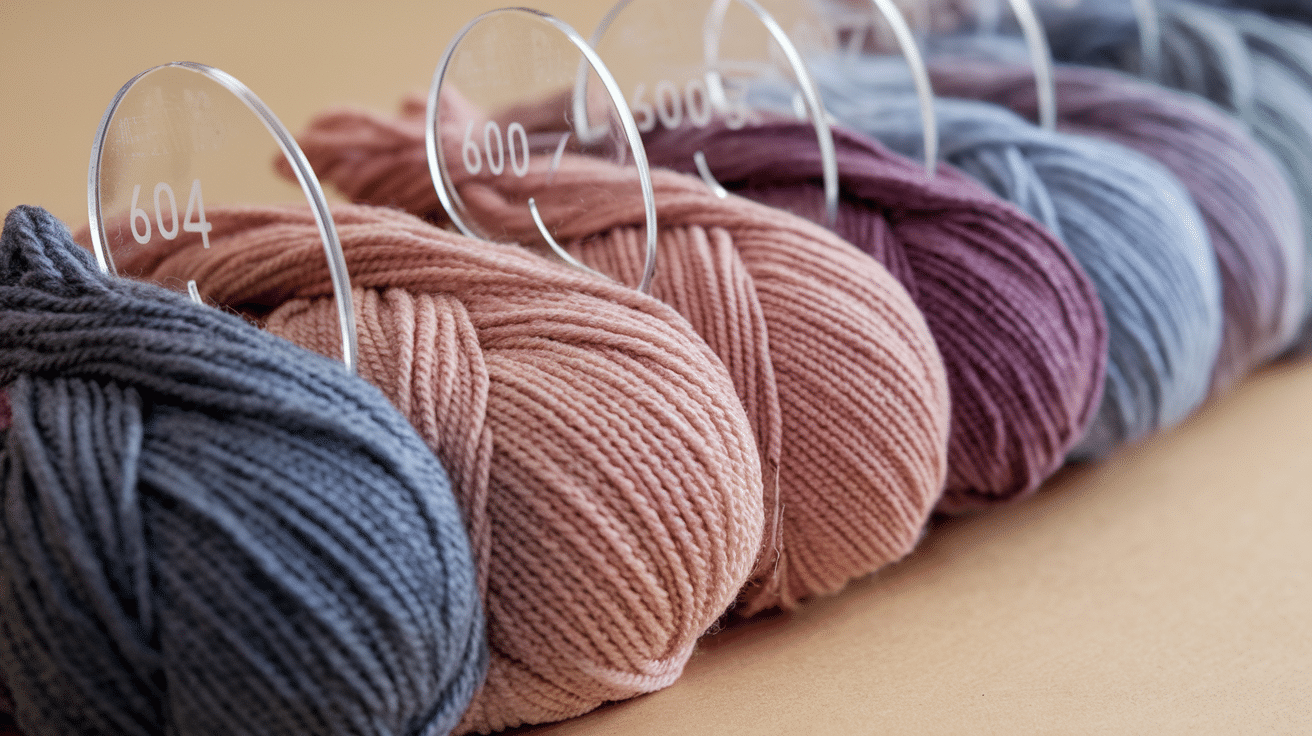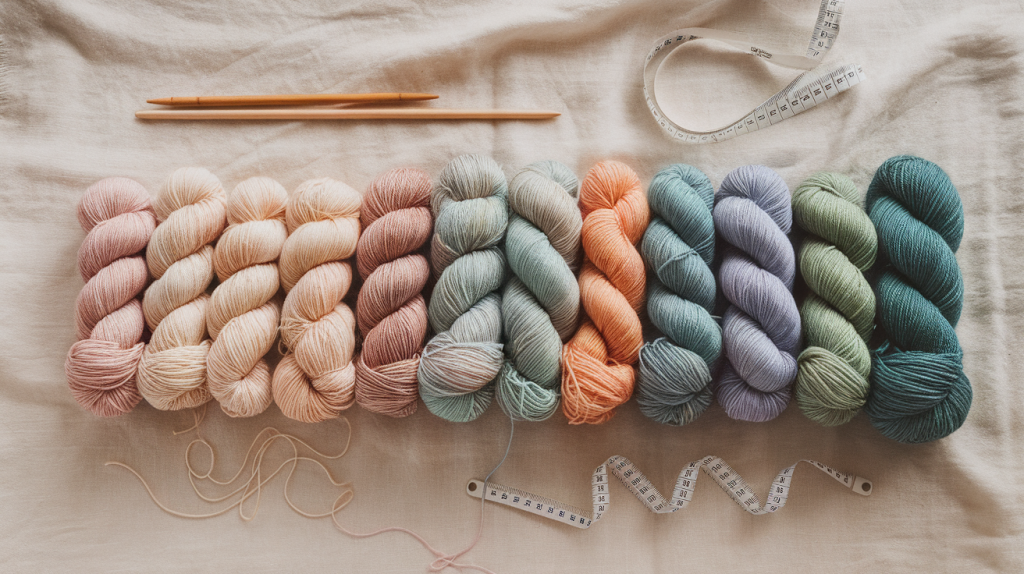Are you having trouble matching yarn weights across different systems? This simple guide to yarn weight conversion will help.
In this article, you’ll discover:
- What yarn weight really means
- How to use my easy conversion calculator
- Tips for handling common conversion challenges
- Ways to ensure your projects turn out perfectly
I’ve been knitting and crocheting for over 15 years, creating hundreds of projects with yarns from around the world. This experience has taught me the frustrations of mismatched yarn weights—and the solutions that actually work.
If you’re trying to substitute a US worsted for a UK DK weight or figuring out what “4-ply” means in the metric system, my straightforward approach will help you succeed. No more wasted yarn or disappointing projects!
Your perfect yarn substitution is just a few simple steps away.
What Exactly is Yarn Weight?

Yarn weight refers to the thickness of your yarn.
It’s not about how heavy the yarn feels in your hand! Instead, it describes how thick or thin each strand is. Yarn weights range from lace (super thin) to jumbo (extra thick).
In the US, we typically use these categories:
- Lace (0)
- Super Fine (1)
- Fine (2)
- Light (3)
- Medium (4)
- Bulky (5)
- Super Bulky (6)
- Jumbo (7)
But here’s where it gets tricky—other countries use different systems! The UK, Australia, and Europe all have their own ways of describing yarn thickness.
Why Do You Need a Yarn Weight Conversion Calculator?
Have you ever found the perfect pattern written by a designer from another country? Or fallen in love with a yarn that uses a different weight system than your pattern?
A yarn weight conversion calculator saves you from:
- Frustrating guesswork
- Projects that turn out the wrong size
- Wasting money on yarn that won’t work
- Hours of painstaking math
I created my calculator after ruining a sweater that took months to make. The European yarn I used was much thinner than I thought, and my sweater ended up fitting my 8-year-old niece instead of me!
How to Use My Yarn Weight Conversion Calculator
Using a yarn weight conversion calculator is simple and saves you time. Just follow these easy steps to switch between different yarn weights without any confusion.
Let me walk you through exactly how to use my conversion tool with detailed steps:
Step 1- Identify Your Current Yarn Weight
Look at your yarn label for weight information.
You might find:
- A number symbol (1-7) inside a yarn skein icon
- Terms like “DK,” “worsted,” or “4-ply.”
- Gauge information (stitches per 4 inches/10cm)
Can’t find the label? No problem! Measure your yarn using the WPI (wraps per inch) method:
- Wrap yarn around a ruler without overlapping
- Count strands in one inch
- Use the WPI chart in the “Challenges” section below
Step 2- Access the Calculator Tool
Click the “Yarn Converter” button at the top of this page or scroll down to the calculator box below. The tool will open in your current browser window—no downloads required.
Step 3- Select Your Starting System
Choose your yarn’s current weight system from the dropdown menu:
- US Standard (0-7)
- UK Standard (Lace, 3-ply, 4-ply, DK, etc.)
- Australia/NZ
- European Metric (nm)
Step 4- Enter Your Yarn Details
Type your yarn’s specific weight information in the provided field:
- For the US system: Enter the number (1-7)
- For the UK system: Select the term (4-ply, DK, Aran, etc.)
- For metric: Enter the nm number
Step 5- Choose Your Target System
From the second dropdown menu, select the system you want to convert to. This is typically the system used in your pattern.
Step 6- Click “Convert” and View Results
Hit the blue “Convert” button, and your results will appear instantly below the calculator.
You’ll see:
- The equivalent weight in your target system
- Recommended needle/hook sizes
- Typical gauge range
- Common pattern types for this weight
Pro tip: Save your results by taking a screenshot or using the “Print Results” button.
Understanding Yarn Gauge and Its Role in Conversion
Gauge is your secret weapon for perfect conversions.
What’s gauge? It’s how many stitches and rows you get per inch (or 10cm) of knitting or crocheting. Even with perfect weight conversion, your gauge might differ between yarns.
Always make a gauge swatch with your new yarn.
This small test piece helps you:
- Confirm your conversion is correct
- Adjust your hook or needle size if needed
- Ensure your final project will be the right size
Common Yarn Weight Conversion Challenges and How to Overcome Them
Converting yarn weights can be tricky, especially when I’m working with different fibers or unfamiliar brands. In this section, I’ll highlight some of the most common challenges I face and share simple ways to overcome them. Whether it’s gauge mismatches or texture issues, I’ve got tips to help you get it right every time.
Vintage Patterns with Outdated Terminology
Old patterns often use terms like “sport weight,” “worsted,” or “baby yarn” without clear modern equivalents. These terms have changed meaning over decades and across regions.
Solution: Ignore the yarn name and look for the recommended gauge in the pattern. A vintage pattern calling for “3-ply baby wool” with 7 stitches per inch likely matches modern fingering weight. When the pattern lacks gauge information, search online for similar vintage patterns with known conversions.
Unmarked or Handspun Yarn
Yarn from thrift stores, destashed collections, or your spinning wheel often comes without labels. Without manufacturer information, determining the weight category becomes challenging.
Solution: Use the WPI (wraps per inch) method. Wrap the yarn around a ruler without overlapping or stretching, count how many strands fit in one inch, then refer to this conversion chart:
- 35+ WPI = Lace (0)
- 30-34 WPI = Super Fine (1)
- 24-30 WPI = Fine (2)
- 20-24 WPI = Light (3)
- 16-20 WPI = Medium (4)
- 12-16 WPI = Bulky (5)
- 8-12 WPI = Super Bulky (6)
International System Differences
A “DK weight” in the UK isn’t the same as an “Aran weight,” but what do they mean in US terms? International patterns often use completely different classification systems.
Solution: Use this quick reference for the most common conversions:
- UK 4-ply = US Super Fine (1)
- UK Double Knit (DK) = US Light (3)
- UK Aran = US Medium (4)
- UK Chunky = US Bulky (5)
My calculator handles the mathematical conversion automatically for metric systems that use numbers (nm, Nm, or tex).
Fiber Content Variations
Different fibers in the same weight category can create dramatically different fabrics. A worsted-weight alpaca drapes differently than a worsted-weight cotton.
Solution: When substituting, consider both weight and fiber content. When switching between plant and animal fibers, adjust your expectations for drape, stretch, and warmth. Even with perfect weight matching, you might need to go up or down a needle size to achieve similar fabric qualities.
Discontinued Yarns in Older Patterns
Trying to follow a pattern that calls for a specific yarn that no longer exists can be particularly frustrating.
Solution: Search yarn substitution databases like Yarnsub.com or Ravelry’s yarn database. These resources maintain information about discontinued yarns and suggest suitable modern alternatives. When all else fails, look for finished project photos and try to match the visual thickness and texture.
Tips for Accurate Yarn Weight Conversions
- Always check your gauge – I can’t stress this enough!
- Consider the project – A blanket might be more forgiving than a fitted sweater.
- Look at the recommended hook/needle size on both yarns – similar sizes often mean compatible weights.
- Remember that plied yarns behave differently than single-ply, even at the same weight.
- When in doubt, go slightly heavier rather than lighter – you can always use a smaller hook or needle.
Conclusion
Yarn weight conversion opens up a world of creative possibilities. With my calculator and these simple tips, you can now confidently use yarns from any country in any pattern.
Don’t let yarn weight confusion hold you back from trying that beautiful British pattern or using that luxurious Italian yarn. The key is understanding the basics and testing with a gauge swatch.
I created these tools because I believe every crafter deserves access to the full spectrum of yarns and patterns available worldwide. Confusing conversion systems shouldn’t limit your crafting!
Happy crafting, and remember—the perfect yarn substitution is just a conversion away.
Frequently Asked Questions
What’s the Difference Between US and UK Yarn Weights?
UK weights typically use ply numbers (2-ply, 4-ply), while US weights use numbered categories (1-7). A UK 4-ply is roughly equivalent to a US Super Fine (1).
How Do I Convert Yarn Weight for A Vintage Pattern from The 1950s?
Focus on the recommended gauge and needle/hook size rather than the yarn name. Vintage “baby yarn” typically matches modern fingering or sports weight.
Will Changing Yarn Weights Affect How Much Yarn I Need for A Project?
Yes, thicker yarns cover more area with less length. Calculate yardage needs by comparing wraps per inch between your original and substitute yarns.
Can Yarn Weights Vary Between Manufacturers Even with The Same Label?
Absolutely! A worsted weight from one brand might be slightly thicker than another’s. Always check the recommended gauge on the label for the most accurate comparison.
How Do I Substitute Yarn When A Pattern Only Lists Meters/100g without Mentioning Weight?
Look for the meters per 100g measurement. Higher numbers (300+) indicate finer yarns, while lower numbers (50-150) suggest bulkier weights. Use this alongside the recommended needle size for accurate conversion.









